Structuring a Residential Satisfaction Model for Predictive Personalization in Mass Social Housing
Abstract
1. Introduction
1.1. Mass Personalized Housing
1.2. Residential Satisfaction Modeling
1.3. Overview of the Chilean Case
1.4. Aims, Scope, and Limitations
2. Methods
2.1. Housing Survey
2.1.1. Case Study Housing Estates
2.1.2. Sample Size and Procedures
2.1.3. Modules and Variables
2.1.4. Statistical Analysis
2.2. Building Energy Simulation
2.3. Household Satisfaction Modelling
3. Results and Discussion
3.1. Residential Satisfaction Survey
3.1.1. Demographics and Housing Modifications
3.1.2. Expectations and Residential Satisfaction
3.1.3. Correlations and Comparative Assessment
3.2. Thermal Performance Evaluation
3.2.1. Discomfort Hours
3.2.2. Space Heating
3.2.3. General Assessment
3.3. Case Study Outcomes
3.4. Residential Satisfaction Modeling
3.4.1. Descriptive Model
3.4.2. Towards Predictive Personalization
4. Conclusions
Author Contributions
Funding
Acknowledgments
Conflicts of Interest
Appendix A
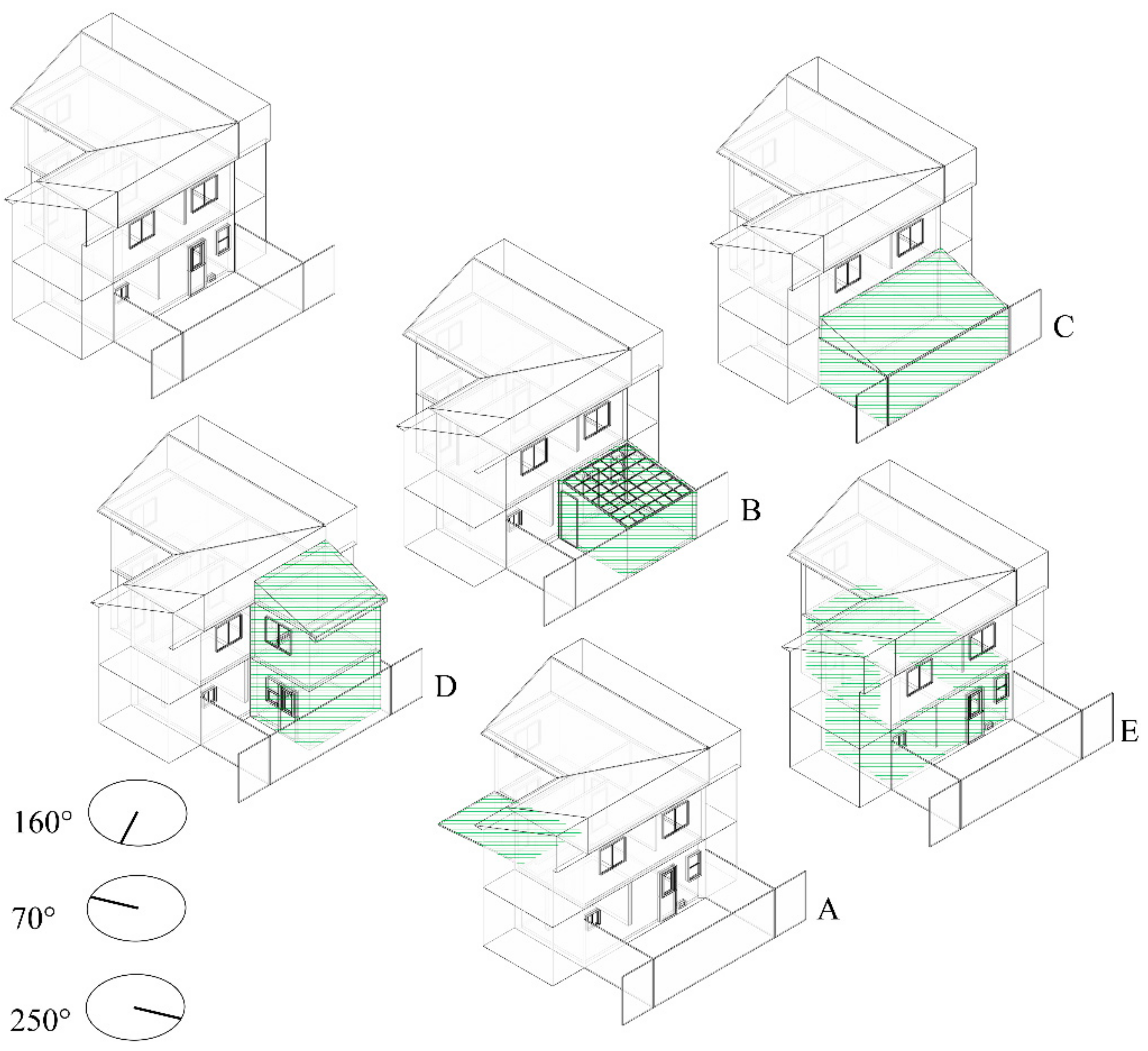
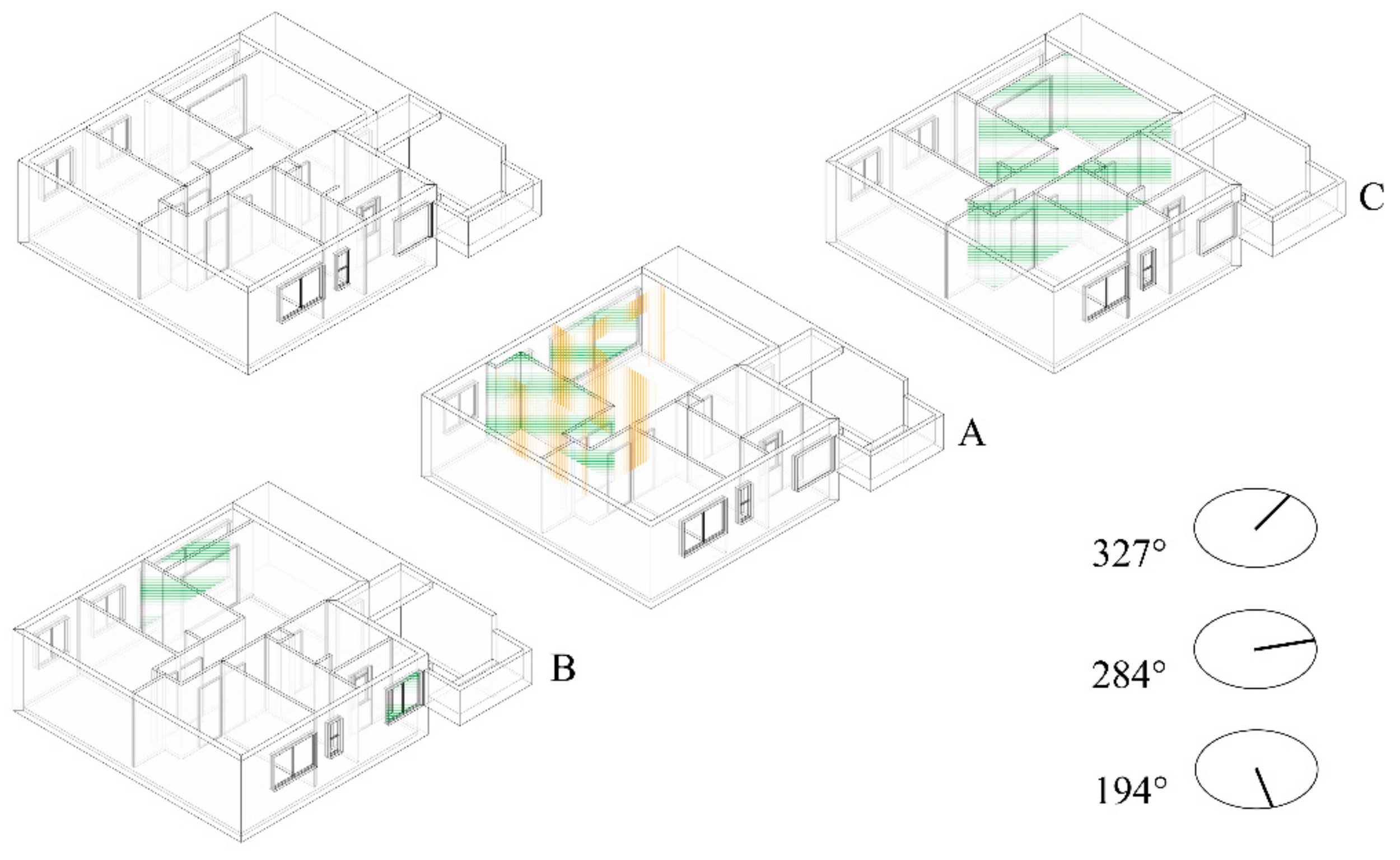
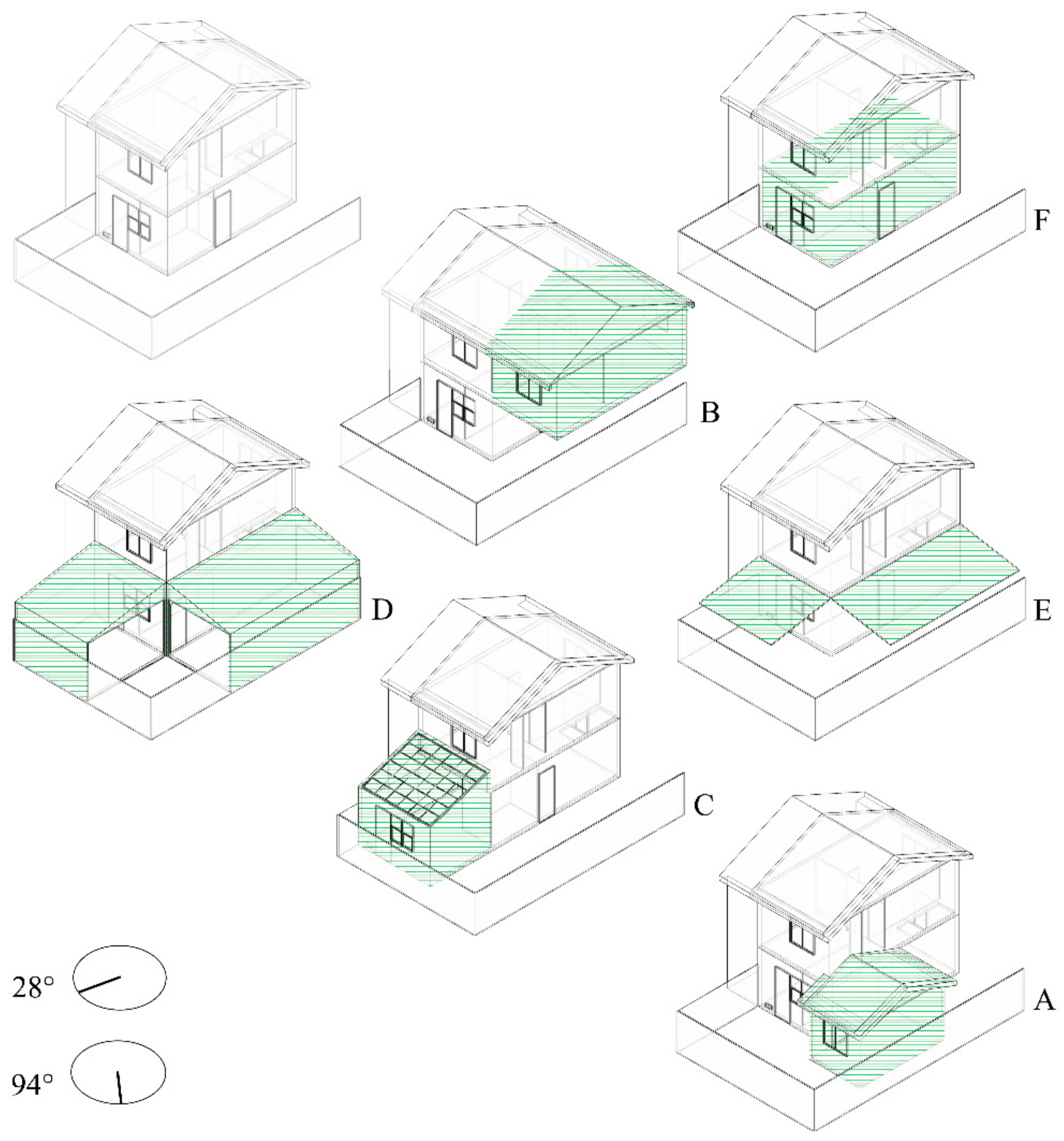
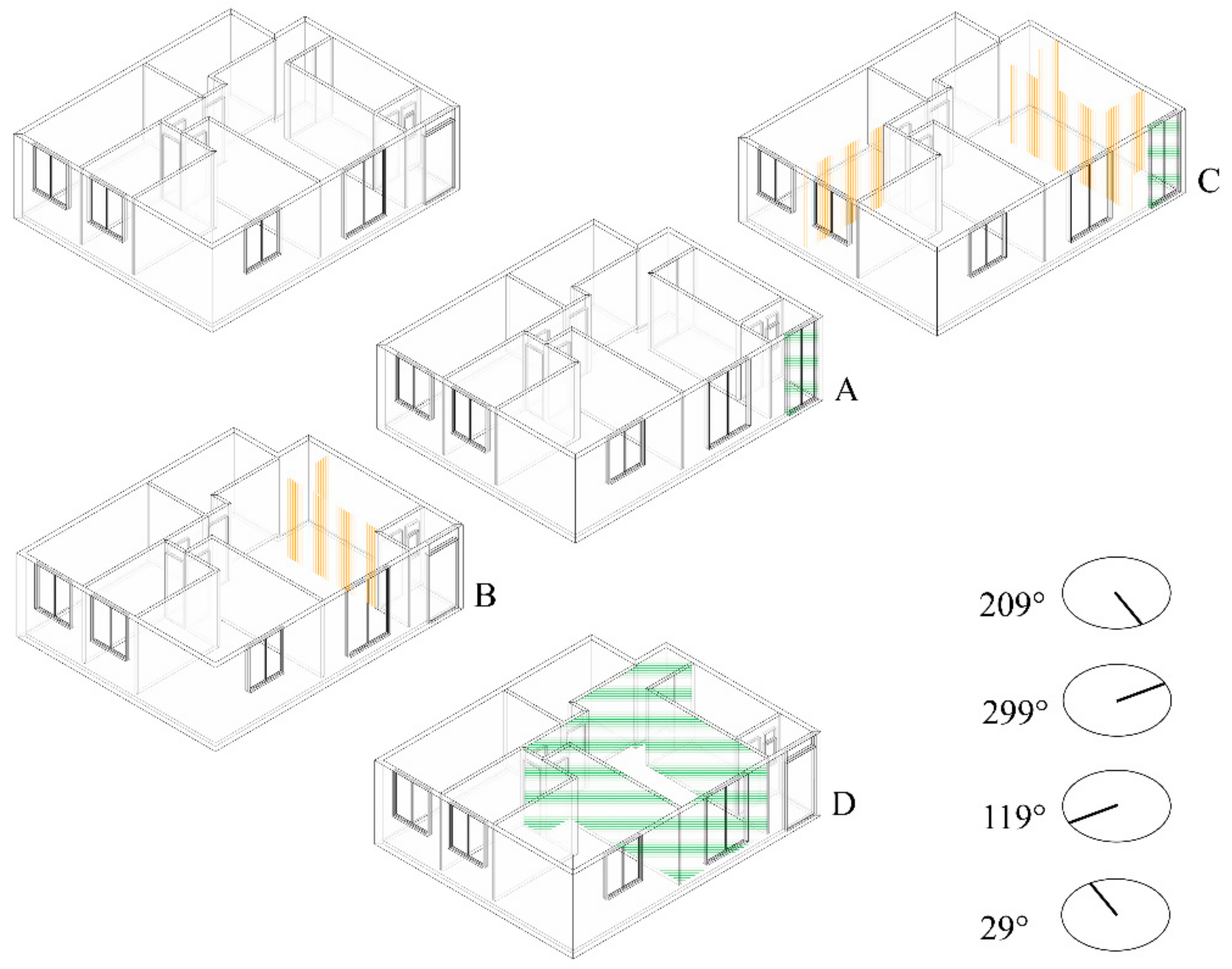
References
- UN Habitat. World Urbanization Prospects 2018; UN-DESA: New York, NY, USA, 2018. [Google Scholar]
- UN Habitat. World Urbanization Prospects: The 2014 Revision, Highlights; Department of Economic and Social Affairs, United Nations: New York, NY, USA, 2014. [Google Scholar]
- Golubchikov, O.; Badyina, A. Sustainable Housing for Sustainable Cities: A Policy Framework for Developing Countries; UNON: Nairobi, Kenya, 2012. [Google Scholar]
- Okpala, D.C.I. Housing production systems and technologies in developing countries: A review of the experiences and possible future trends/prospects. Habitat Int. 1992, 16, 9–32. [Google Scholar] [CrossRef]
- Turner, J.F.C.; Roberts, B. The Self-Help Society. In The Exploding Cities; Wilsher, P., Righter, R., Eds.; Andre Deutch Ltd.: London, UK, 1975. [Google Scholar]
- Davis, S. The Architecture of Affordable Housing; University of California Press: Berkeley, CA, USA, 1995. [Google Scholar]
- Tipple, G. Housing extensions as sustainable development. Habitat Int. 1996, 20, 367–376. [Google Scholar] [CrossRef]
- Habraken, N.J. Supports: An Alternative to Mass Housing; The Architectural Press: London, UK, 1972. [Google Scholar]
- Hays, R.A. Habitat for humanity: Building social capital through faith based service. J. Urban Aff. 2002, 24, 247–269. [Google Scholar] [CrossRef]
- Haramoto, E.; Chiang, P.; Sepúlveda, R.; Kliwadenko, I. Vivienda Social: Tipología de Desarrollo Progresivo; Instituto de la Vivienda, Universidad de Chile/Centro de Estudios de la Vivienda, Universidad Central: Santiago, Chile, 1987. [Google Scholar]
- Greene, M.; Rojas, E. Incremental construction: A strategy to facilitate access to housing. Environ. Urban. 2008, 20, 89–108. [Google Scholar] [CrossRef]
- Aravena, A.; Iacobelli, A. Incremental Housing and Participatory Design Manual; Hatje Cantz: Ostfildern, Germany, 2012. [Google Scholar]
- Priemus, H. Flexible housing: Fundamentals and background. Open H. Int. 1993, 18, 19–26. [Google Scholar]
- Friedman, A. The Adaptable House: Designing Homes for Change; McGraw Hill Professional: New York, NY, USA, 2002. [Google Scholar]
- Jones, P.B.; Petrescu, D.; Till, J. (Eds.) Architecture and Participation; Routledge: London, UK, 2005. [Google Scholar]
- Simonsen, J.; Robertson, T. (Eds.) Routledge International Handbook of Participatory Design; Routledge: New York, NY, USA, 2013. [Google Scholar]
- Bamberger, M. The role of self-help housing in low-cost shelter programmes for the Third World. Built Environ. 1982, 8, 95–107. [Google Scholar]
- Bredenoord, J.; Lindert, P.V. Pro-poor housing policies: Rethinking the potential of assisted self-help housing. Habitat Int. 2010, 34, 278–287. [Google Scholar] [CrossRef]
- UN Habitat. Financing Urban Shelter: Global Report in Human Settlements 2005; Earthscan: Nairobi, Kenya, 2005. [Google Scholar]
- Bunster, V.; Noguchi, M.; Kvan, T. Mass Personalisation. In ZEMCH: Toward the Delivery of Zero Energy Mass Custom Homes; Noguchi, M., Ed.; Springer: New York, NY, USA, 2016; pp. 121–149. [Google Scholar]
- Bunster, V.; Noguchi, M. Profiling space heating behavior in Chilean social housing: Towards personalization of energy efficiency measures. Sustainability 2015, 7, 7973–7996. [Google Scholar] [CrossRef]
- Tseng, M.M.; Jiao, R.J.; Wanga, C. Design for mass personalization. CIRP Ann. Manuf. Technol. 2010, 59, 175–178. [Google Scholar] [CrossRef]
- Kumar, A. From mass customization to mass personalization: A strategic transformation. Int. J. Flex. Manuf. Syst. 2008, 19, 533–547. [Google Scholar] [CrossRef]
- Tseng, M.M.; Jiao, J.; Merchant, M.E. Design for mass customization. CIRP Ann. Manuf. Technol. 1996, 45, 153–156. [Google Scholar] [CrossRef]
- Piller, F.T.; Tseng, M.M. (Eds.) Handbook of Research in Mass Customization and Personalization; World Scientific: Singapore, 2009; Volume 2. [Google Scholar]
- Pine, B.J., II. Mass Customization: The New Frontier in Business Competition; Harvard Business School Press: Boston, MA, USA, 1993. [Google Scholar]
- Zhou, F.; Ji, Y.; Jiao, R.J. Affective and cognitive design for mass personalization: Status and prospect. J. Intell. Manuf. 2013, 24, 1047–1069. [Google Scholar] [CrossRef]
- Noguchi, M.; Hadjri, K. Mass custom design for sustainable housing development. In Handbook of Research in Mass Customizacion and Personalization; Piller, F.T., Tseng, M.M., Eds.; World Scientific Publishing: London, UK, 2010; Volume 2, pp. 892–910. [Google Scholar]
- Di Sivo, M.; Angelucci, F. Mass customization process for the Social Housing. Potentiality, critical points, research lines. Techne 2012, 4, 132. [Google Scholar]
- Zhou, F.; Xu, Q.; Jiao, R.J. Fundamentals of product ecosystem design for user experience. Res. Eng. Des. 2011, 22, 43–61. [Google Scholar] [CrossRef]
- Zhou, F.; Jiao, R.J.; Xu, Q.; Takahashi, K. User experience modeling and simulation for product ecosystem design based on fuzzy reasoning petri nets. IEEE Trans. Syst. Manand Cybern. Part A Syst. Hum. 2012, 42, 201–212. [Google Scholar] [CrossRef]
- Lu, M. Determinants of residential satisfaction: Ordered logit vs. regression models. Growth Chang. 1999, 30, 264–287. [Google Scholar] [CrossRef]
- Morris, E.W.; Winter, M. A theory of family housing adjustment. J. Marriage Fam. 1975, 37, 79–88. [Google Scholar] [CrossRef]
- Morris, E.W.; Crull, S.R.; Winter, M. Housing norms, housing satisfaction and the propensity to move. J. Marriage Fam. 1976, 38, 309–320. [Google Scholar] [CrossRef]
- Galster, G.C.; Hesser, G.W. Residential satisfaction: Compositional and contextual correlates. Environ. Behav. 1981, 13, 735–758. [Google Scholar] [CrossRef]
- Abu Ghazzeh, T.M. Environmental messages in multiple-family housing: Territory and personalization. Landsc. Res. 2000, 25, 97–115. [Google Scholar] [CrossRef]
- Weidemann, S.; Anderson, J.R. A conceptual framework for residential satisfaction. In Home Environments; Springer: New York, NY, USA, 1985; pp. 153–182. [Google Scholar]
- Amérigo, M.; Aragonés, J.I. A theoretical and methodological approach to the study of residential satisfaction. J. Environ. Psychol. 1997, 17, 47–57. [Google Scholar] [CrossRef]
- Parkes, A.; Kearns, A.; Atkinson, R. What makes people dissatisfied with their neighbourhoods? Urban Stud. 2002, 39, 2413–2438. [Google Scholar] [CrossRef]
- Forte, F.; Russo, Y. Evaluation of user satisfaction in public residential housing—A case study in the outskirts of Naples, Italy. IOP Conf. Ser. Mater. Sci. Eng. 2017, 245, 052063. [Google Scholar]
- Galster, G. Identifying the correlates of dwelling satisfaction: An empirical critique. Environ. Behav. 1987, 19, 539–568. [Google Scholar] [CrossRef]
- UN Habitat. The Habitat Agenda: Chapter IV: B. Adequate shelter for all. In UN Documents: Gathering a Body of Global Agreements; Education, N.C.O., Ed.; United Nations: Istambul, Turkey, 1996. [Google Scholar]
- Seth, N.; Deshmukh, S.G.; Vrat, P. Service quality models: A review. Int. J. Qual. Reliab. Manag. 2005, 22, 913–949. [Google Scholar] [CrossRef]
- Ghobadian, A.; Speller, S.; Jones, M. Service quality: Concepts and models. Int. J. Qual. Reliab. Manag. 1994, 11, 43–66. [Google Scholar] [CrossRef]
- Oliver, R.L. Effect of expectation and disconfirmation on postexposure product evaluations: An alternative interpretation. J. Appl. Psychol. 1977, 62, 480–486. [Google Scholar] [CrossRef]
- Bharati, P.; Chaudhary, A. Product customization on the web: An empirical study of factors impacting choiceboard user satisfaction. Inf. Resour. Manag. J. 2006, 19, 69–81. [Google Scholar] [CrossRef]
- Liang, T.-P.; Lai, H.J.; Ku, Y.C. Personalized content recommendation and user satisfaction: Theoretical synthesis and empirical findings. J. Manag. Inf. Syst. 2006, 23, 45–70. [Google Scholar] [CrossRef]
- Grimmelikhuijsen, S.; Porumbescu, G.A. Reconsidering the expectancy disconfirmation model. Three experimental replications. Public Manag. Rev. 2017, 19, 1272–1292. [Google Scholar] [CrossRef]
- Held, G. Políticas de Viviendas de Interés Social Orientadas Al Mercado: Experiencias Recientes Con Subsidios a La Demanda En CHILE, Costa Rica y Colombia; CEPAL: Santiago, Chile, 2000. [Google Scholar]
- Chamorro, C. Política habitacional en Chile: Historia, resultados y desafíos. In Work Documents; Chilean Construction Chamber: Santiago, Chile, 2013. [Google Scholar]
- Haramoto, E.; Jirón, P.; Tapia, R.; Sepúlveda, R.; Sepúlveda, O.; Zapata, I.; Rugiero, A.; Izaurieta, R. Sistema Medición Satisfacción Beneficiarios Vivienda Básica: Síntesis del Informe de Consultoría INVI-FAU-UCH; Instituto de la Vivienda; Facultad de Arquitectura y Urbanismo, Universidad de Chile: Santiago, Chile, 2002. [Google Scholar]
- Sugranyes, A. La política habitacional en Chile, 1980–2000: Un éxito liberal para dar techo a los pobres. In Los Con Techo: Un Desafío Para La Política de Vivienda Social; Rodríguez, A., Sungranyes, A., Eds.; Ediciones SUR: Santiago, Chile, 2005. [Google Scholar]
- Arriagada, C.; Sepúlveda, D. Satisfacción Residencial en la Vivienda Básica SERVIU: La Perspectiva del Ciclo Familiar; Ministerio de Vivienda y Urbanismo: Santiago, Chile, 2001; Volume 311.
- Atria, J. Social capital and volunteering: The keys for solidary financing for social housing. The Un Techo para Chile Foundation case. Rev. INVI 2007, 22, 13–30. [Google Scholar]
- Naranjo, C.; Purcell, J. The qualitative dimension in the application system for the solidarity housing fund I. Psicoperspectivas 2010, 9, 181–202. [Google Scholar]
- Hidalgo, R. La Vivienda Social en Chile y la Construcción del Espacio Urbano en el Santiago del Siglo XX; Pontificia Universidad Católica de Chile: Santiago, Chile, 2005. [Google Scholar]
- Hidalgo, R.; Peterson, V.C.; Santana, D. La espacialidad neoliberal de la producción de vivienda social en las áreas metropolitanas de Valparaíso y Santiago (1990–2014): Hacia la construcción idelógica de un rostro humano? Cad. Metrópole 2017, 19, 513–535. [Google Scholar]
- Katsura, H.M.; Romanik, C.T. Ensuring Access to Essential Services: Demand-Side Housing Subsidies; World Bank: Washington, DC, USA, 2002. [Google Scholar]
- Government of Chile. Ordenanza General de Urbanismo y Construcciones; D.S. No.47; Diario Oficial de la República de Chile: Santiago, Chile, 1992.
- Government of Chile. Reglamento del Programa Fondo Solidario de Elección de Vivienda; D.S. No.49; Ministerio de Vivienda y Urbanismo: Santiago, Chile, 2011; pp. 1–58. [Google Scholar]
- Muñoz, T.L. Evolución del espacio doméstico en ‘blocks’ de vivienda social: Autoconstrucción y vulnerabilidad en conjuntos de vivienda básica. Rev. CIS 2011, 15, 3–26. [Google Scholar]
- Kellet, P.; Haramoto, E.; Toro, A. Dweller-initiated changes and transformations of social housing: Theory and practice in the Chilean context. Open House Int. 1993, 18, 3–10. [Google Scholar]
- García, R.; Donath, D.; González, F. Growth patterns in incremental self-build housing in Chile. Open House Int. 2009, 34, 18–25. [Google Scholar]
- Kellett, P.; Toro, A.; Haramoto, E. Cambios iniciados por los habitantes y transformaciones en la vivienda social: Teoría y práctica en el contexto chileno. Bol. INVI 1994, 21, 3–16. [Google Scholar]
- Arriagada, C.; Moreno, J.C. Atlas de la Evolución del Déficit Habitacional en Chile 1992–2002; Departamento de Estudios, Ministerio de Vivienda y Urbanismo: Santiago, Chile, 2006. [Google Scholar]
- Ministerio de Vivienda y Urbanismo. Manual Para el Diseño y Ejecución de Planes de Habilitación Social, Fondo Solidario de Vivienda; Habitacional, D.A., Ed.; Gobierno de Chile: Santiago, Chile, 2008. [Google Scholar]
- De Federico, I. Plan de habilitación social: Los usuarios opinan. Rev. CIS 2006, 8, 28–39. [Google Scholar]
- Saborido, M.; Miranda, M.; Zamorano, H. Informe Final de Evaluación Programa de Asistencia Técnica y Social; Ministerio de Vivienda y Urbanismo, Secretaría de Vivienda y Urbanismo: Santiago, Chile, 2010.
- Rubio Bellido, C.; Pérez Fargallo, A.; Pulido Arcas, J.A.; Trebilcock, M. Application of adaptive comfort behaviors in Chilean social housing standards under the influence of climate change. In Building Simulation; Tsinghua University Press: Beijing, China, 2017; pp. 933–947. [Google Scholar]
- Pérez Fargallo, A.; Rubio Bellido, C.; Pulido Arcas, J.A.; Trebilcock, M. Development policy in social housing allocation: Fuel poverty potential risk index. Indoor Built Environ. 2017, 26, 980–998. [Google Scholar] [CrossRef]
- Comerio, M.C. Housing recovery lessons from Chile. J. Am. Plan. Assoc. 2014, 80, 340–350. [Google Scholar] [CrossRef]
- Platt, S. Reconstruction in Chile Post 2010 Earthquake; Cambridge Architectural Research Ltd.: Cambridge, UK, 2012. [Google Scholar]
- Krosnick, J.A.; Presser, S. Question and questionnaire design. In Handbook of Survey Research, 2nd ed.; Wright, J.D., Marsden, P.V., Eds.; Elsevier: San Diego, CA, USA, 2010; pp. 263–314. [Google Scholar]
- ASHRAE. Thermal environmental conditions for human occupancy. In ANSI/ASHRAE Standard 55-1992; Heating, A.S.O., Ed.; ERDAS Inc.: Atlanta, GA, USA, 2010. [Google Scholar]
- Burgoon, J.K.; Bonito, J.A.; Lowry, P.B.; Humpherys, S.L.; Moody, G.D.; Gaskin, J.E.; Giboney, J.S. Application of expectancy violations theory to communication with and judgments about embodied agents during a decision-making task. Int. J. Hum. Comput. Stud. 2016, 91, 24–36. [Google Scholar] [CrossRef]
- Hackel, L.S.; Ruble, D.N. Changes in the marital relationship after the first baby is born: Predicting the impact of expectancy disconfirmation. J. Personal. Soc. Psychol. 1992, 62, 944–957. [Google Scholar] [CrossRef]
- Van Rijn, H.; Johnson, A.; Taatgen, N. Cognitive user modelling. In Handbook of Human Factors in Web Design, 2nd ed.; Vu, K.P.L., Proctor, R.W., Eds.; CRC Press: Boca Raton, FL, USA, 2011; pp. 527–542. [Google Scholar]
- Brown, S.A.; Venkatesh, V.; Goyal, S. Expectation confirmation in information systems research: A test of competing models. MIS Q. 2014, 38, 729–756. [Google Scholar] [CrossRef]
- Jirón, P.; Toro, A.; Caquimbo, S.; Goldsack, L.; Martínez, L.; Colonelli, P.; Hormazábal, N.; Sarmiento, P. Bienestar Habitacional: Guía de Diseño Para un Hábitat Residencial Sustentable; Andros Impresores: Santiago, Chile, 2004. [Google Scholar]
- Bustamante, W.; Rozas, Y.; Cepeda, R.; Encinas, F.; Martínez, P. Guía de Diseño Para la Eficiencia Energética en la Vivienda Social; Ministerio de Vivienda y Urbanismo; Grafhika Copy Center Ltda.: Santiago, Chile, 2009.
- Escorcia, O.; García, R.; Trebilcock, M.; Celis, F.; Bruscato, U. Envelope improvements for energy efficiency of homes in the south-central Chile. Inf. Constr. 2012, 64, 563–574. [Google Scholar] [CrossRef]
- Celis, F.; Diaz, M.; Echeverría, E.; García, R.; Escorcia, O.; Trebilcock, M. Incidence of architectural configuration on energy efficiency of dwellings in the centre-south of Chile. In Proceedings of the PLEA 2012-28th Conference, Opportunities, Limits & Needs Towards an Environmentally Responsible Architecture, Lima, Perú, 7–9 November 2012. [Google Scholar]
- Acevedo, F.; Arrieta, B.; González, C.; González, F.; Jorquera, C.; Mora, M.E.; Soto, N. Evaluación de la Satisfacción Residencial de Los Beneficiarios del Fondo Solidario de Vivienda (FSV); Pontificia Universidad Católica de Chile: Santiago, Chile, 2007. [Google Scholar]
- Andrade, M.; Aguirre, C.; Mora, M.E. Antecedentes para una evaluación de la satisfacción residencial de los beneficiarios del fondo solidario de vivienda (FSV). Rev. Constr. 2007, 6, 42–51. [Google Scholar]
- Andrade, M.; Aguirre, C.; Mora, M.E.; Pizarro, J. Evaluación de la satisfacción residencial de beneficiarios del fondo solidario de vivienda (FSV). Rev. CIS 2008, 11, 52–59. [Google Scholar]
- Oliver, R.L.; Burke, R.R. Expectation processes in satisfaction formation: A field study. J. Serv. Res. 1999, 1, 196–214. [Google Scholar] [CrossRef]
- Bunster, V.; Bustamante, W.; García, R.; Noguchi, M.; Kvan, T. Exploring the impacts of personalisation on thermal efficiency of Chilean social housing. In Proceedings of the 6th International Conference on Zero Energy Mass Custom Housing (ZEMCH 2018), Melbourne, Australia, 29 January–1 February 2018; pp. 595–612. [Google Scholar]
- Bunster, V.; Noguchi, M.; García, R.; Kvan, T. Personalisation strategies and residential satisfaction in Chilean social housing. In Proceedings of the ZEMCH 2015, Zero Energy Mass Custom Home International Conference and Technical Seminars, Bari and Lecce, Italy, 22–25 September 2015. [Google Scholar]
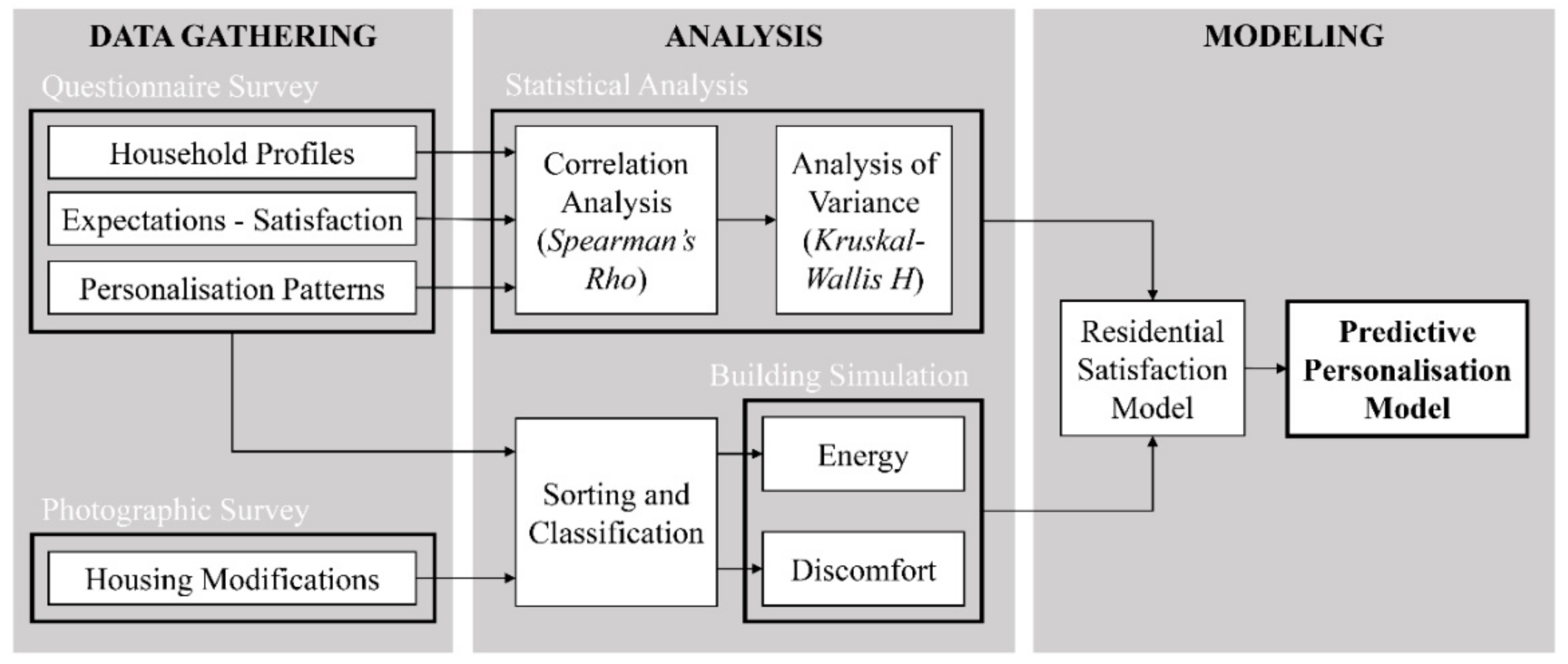


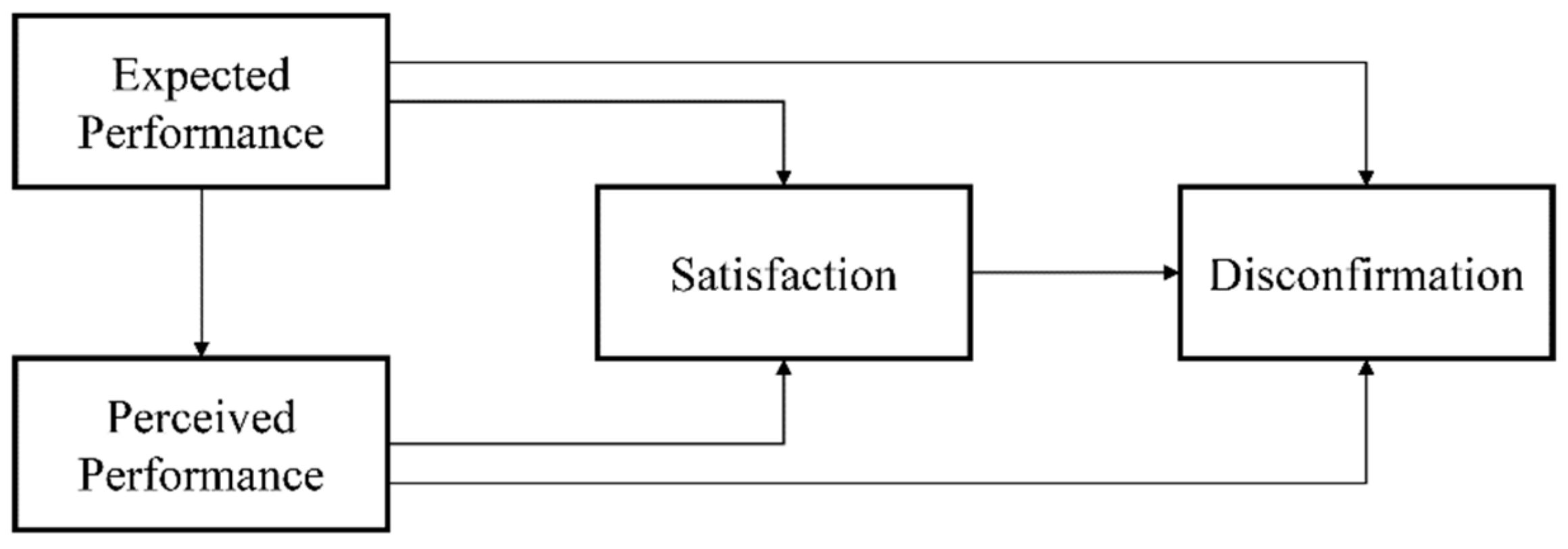
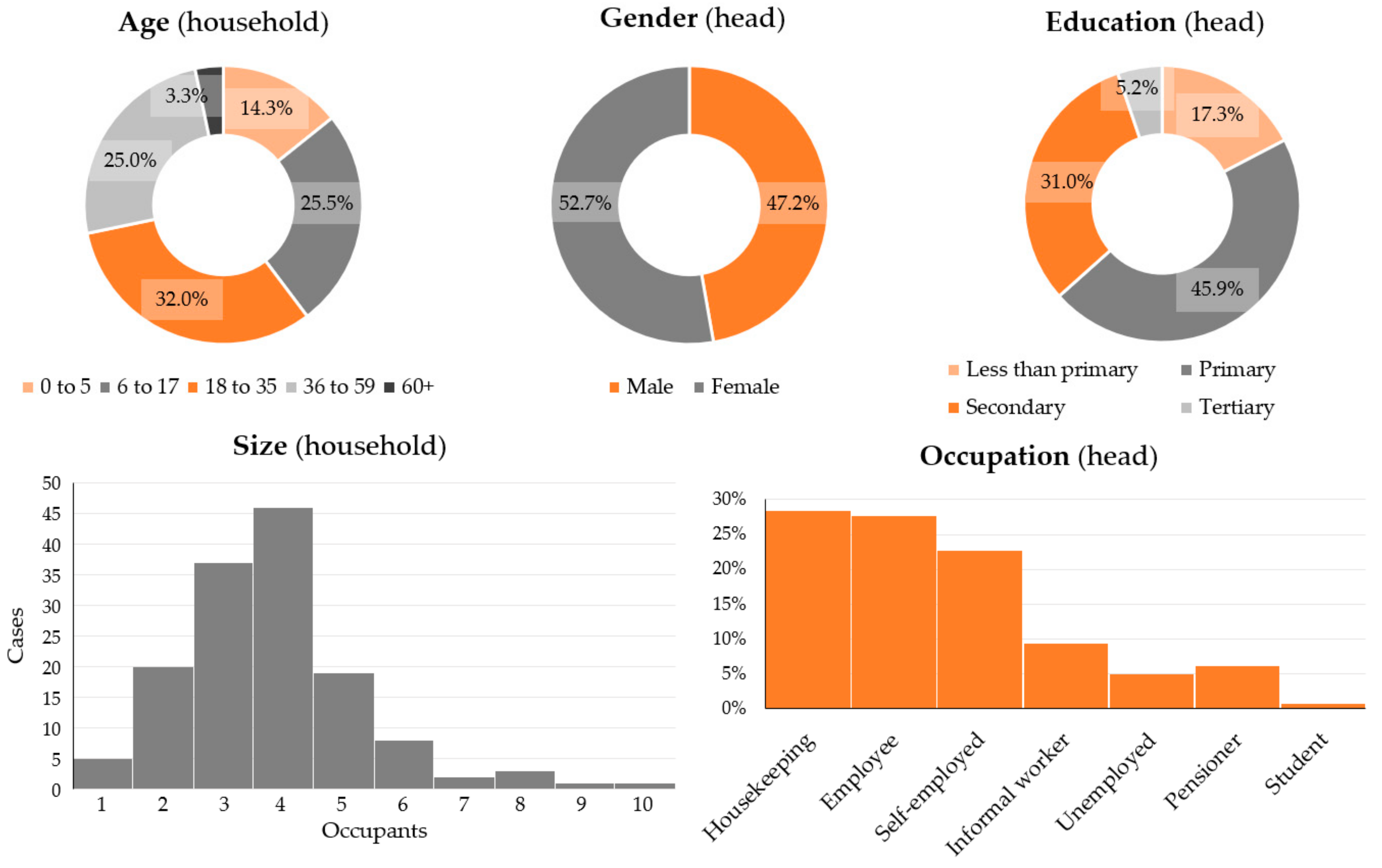
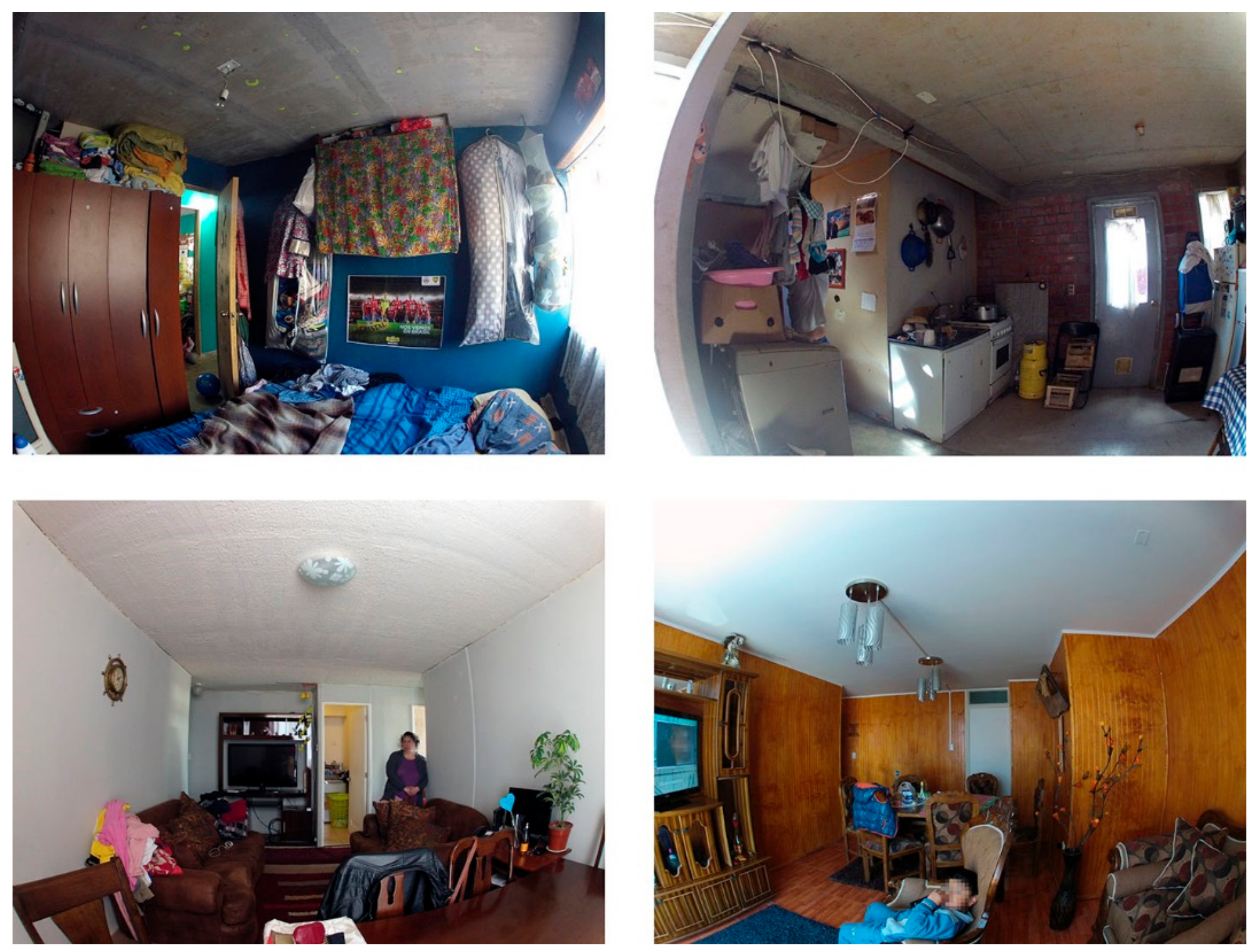
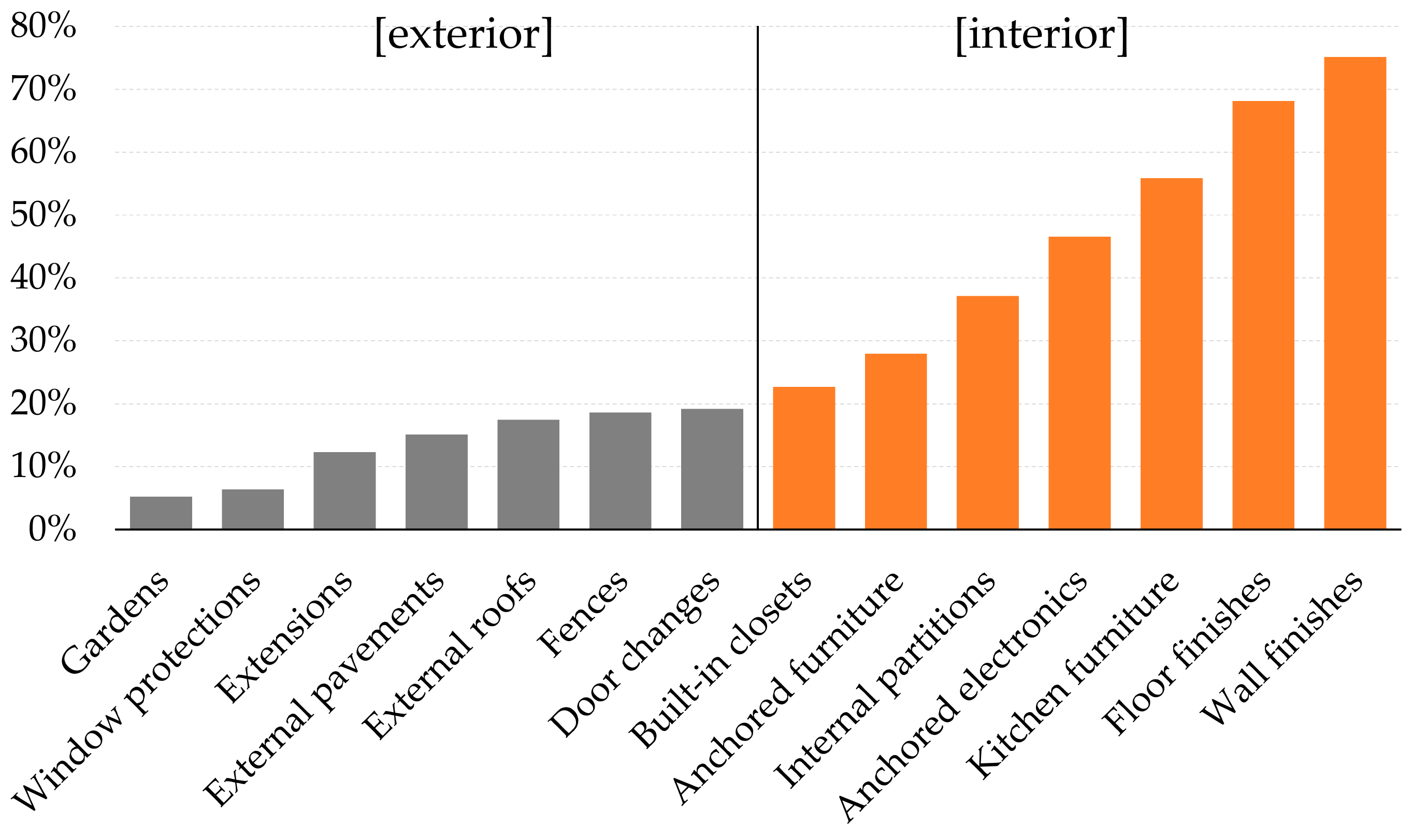

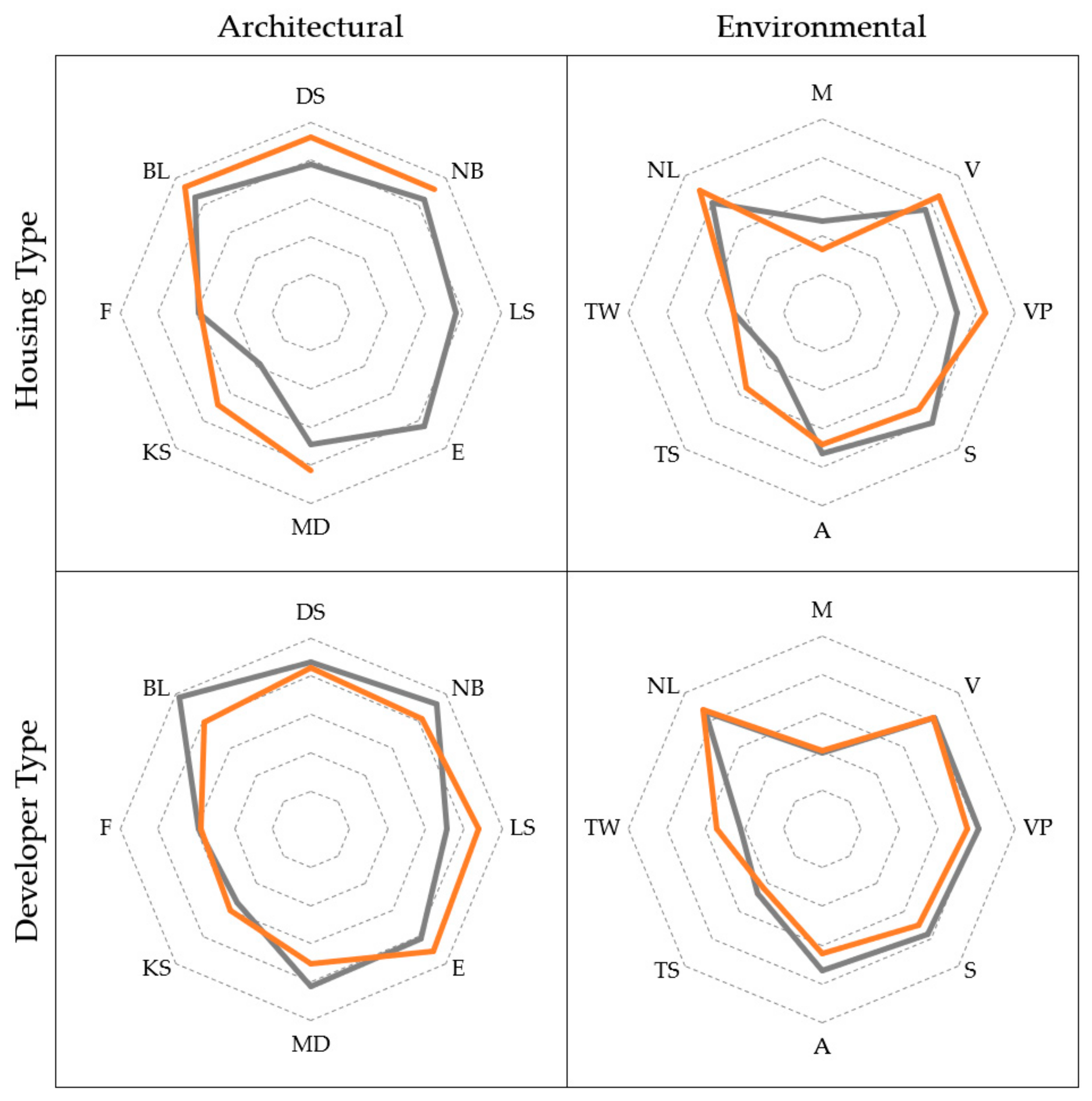
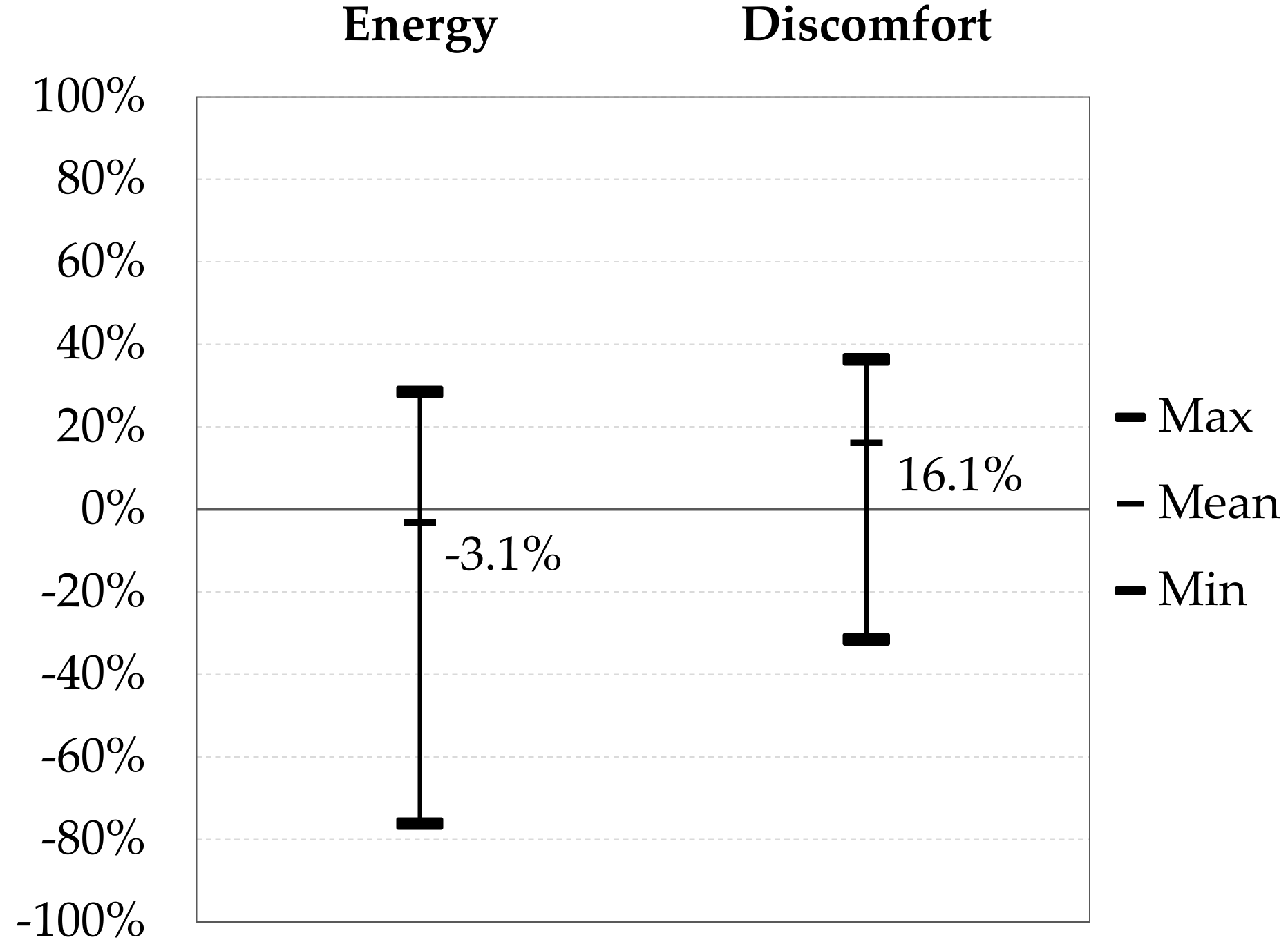
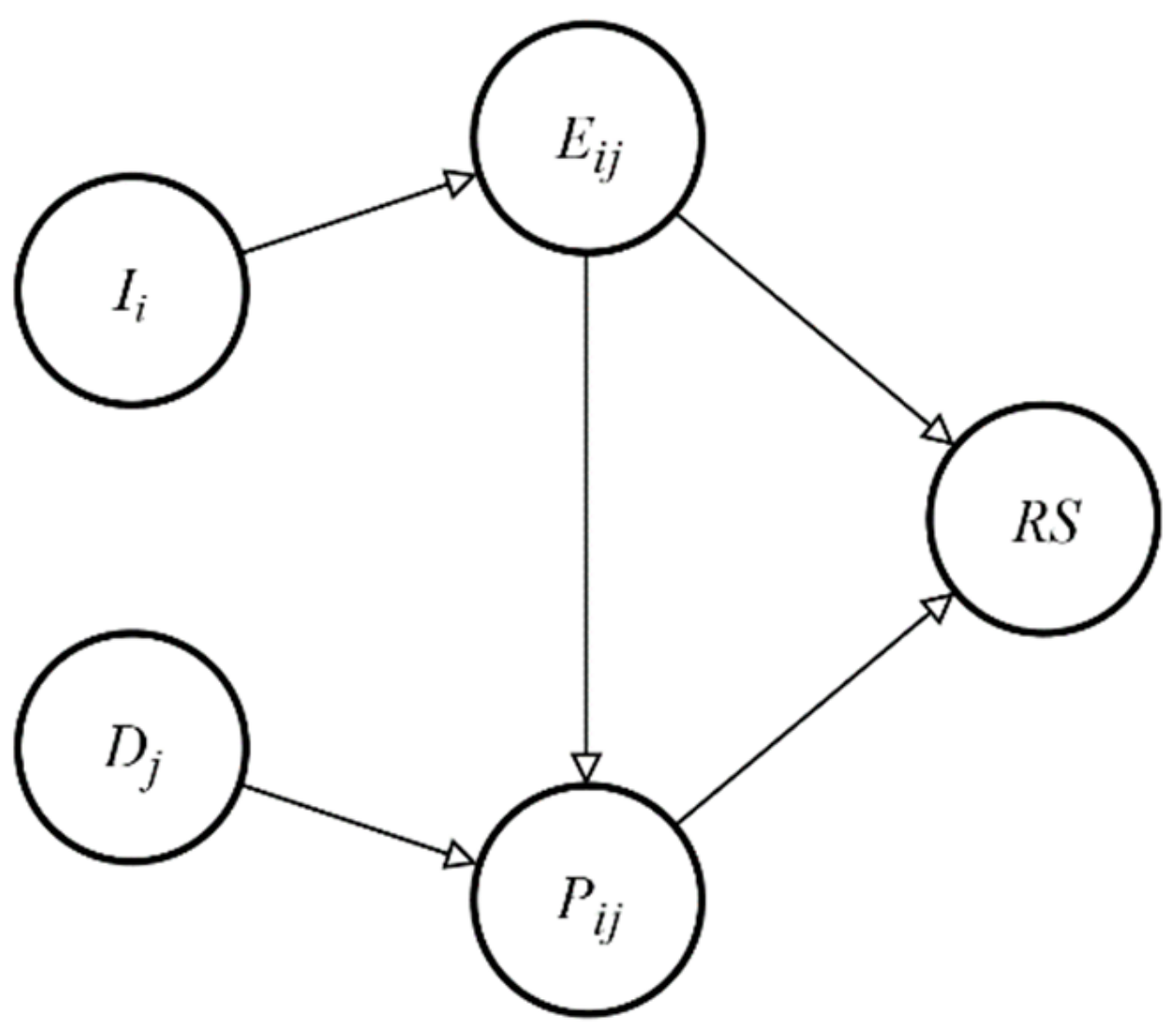
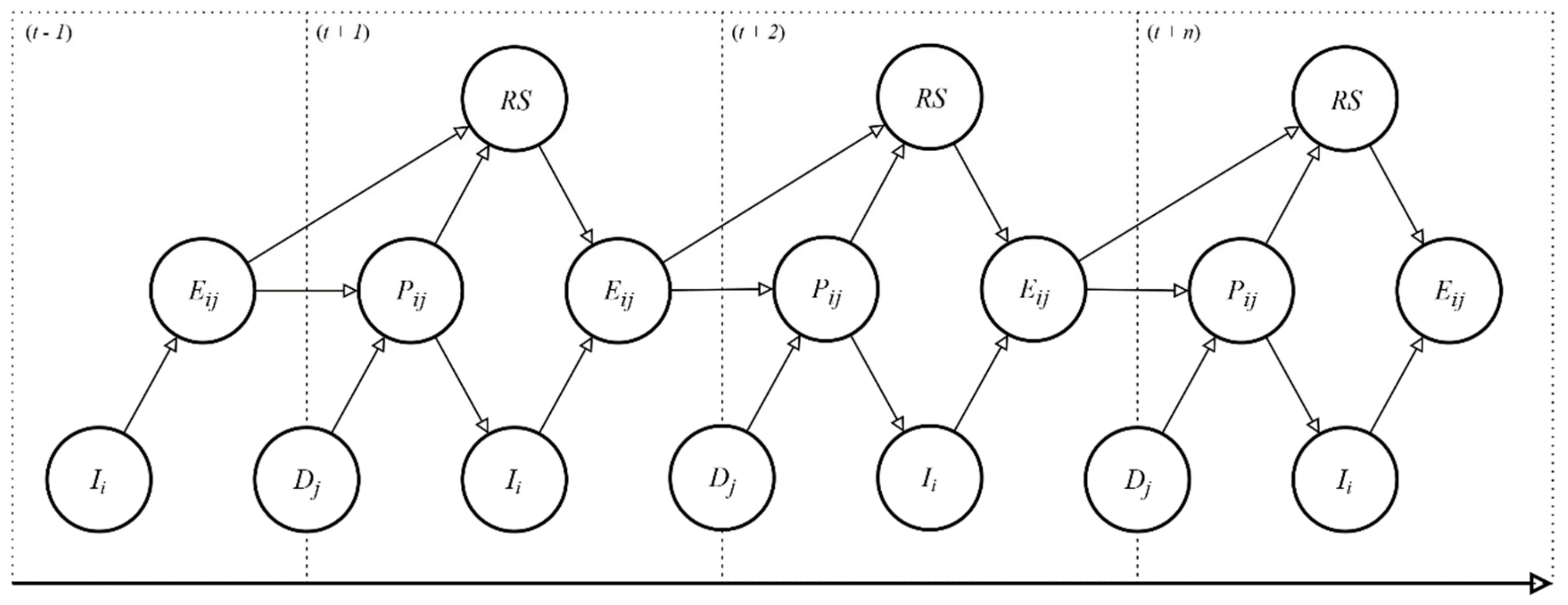
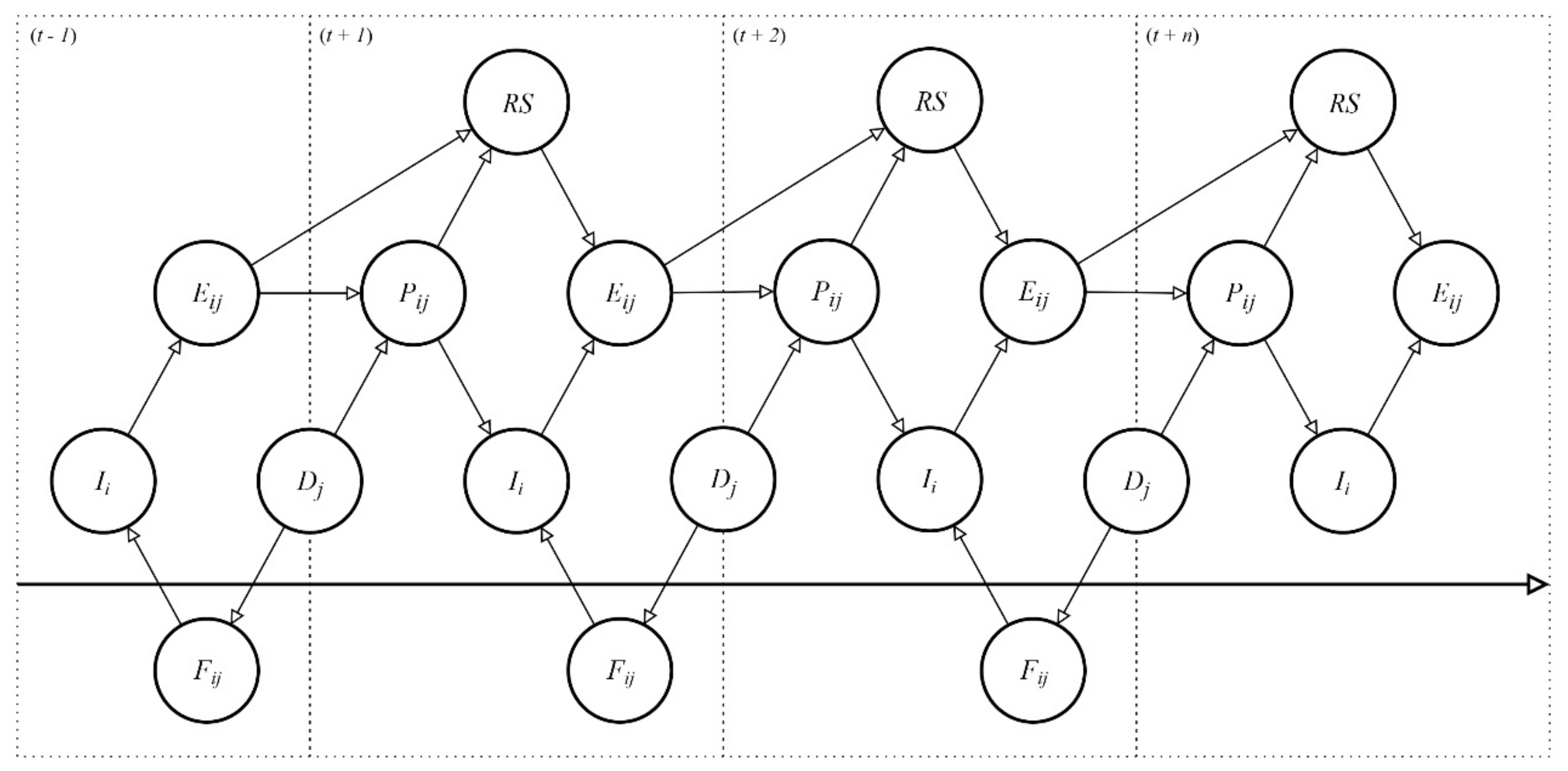
| Element | TR | JPUS | |
|---|---|---|---|
| Envelope Materials | Walls G. Floor | Ceramic brickwork 154 mm | Reinforced concrete 150 mm a |
| Walls 1st Floor | Timber framing 100 mm | ||
| Roofs | Timber framing 80 mm | Timber framing 100 mm | |
| Floors | Concrete slab 100 mm | Concrete slab 150 mm | |
| Insulation Materials | Walls G. Floor | EPS 20 mm | EPS 20 mm a |
| Walls 1st Floor | Cement Plaster 20 mm | ||
| Roofs | Glass wool 100 mm | Glass wool 100 mm | |
| Opening Materials | Windows | Single glazed 3 mm | Single glazed 3 mm |
| Doors | Hollow core MDF 4 mm | Hollow core MDF 4 mm | |
| U-values [W/m2·K] | Walls G. Floor | 1.41 | 1.19 a |
| Walls 1st Floor | 1.04 | ||
| Roofs | 0.33 | 0.34 |
| Element | SDH1 | SDH2 | |
|---|---|---|---|
| Envelope Component Materials | Walls | Timber framing 90 mm | Reinforced concrete 150 mm |
| Roofs | Timber framing 80 mm | Timber framing 100 mm | |
| Floors | Concrete slab 100 mm | Concrete slab 100 mm | |
| Insulation Materials | Walls | EPS 20 mm | EPS 20 mm |
| Roofs | Glass wool 100 mm | Glass wool 100 mm | |
| Opening Materials | Windows | Single glazed 3 mm | Single glazed 3 mm |
| Doors | Hollow core MDF 4 mm | Hollow core MDF 4 mm | |
| U-values [W/m2·K] | Walls | 1.34 | 1.21 |
| Roofs | 0.32 | 0.38 |
| TR | JPUS | SDH1 | SDH2 | |
|---|---|---|---|---|
| Type | Terraced | Apartment | Semi-detached | Apartment |
| Surface [m2] | 58 | 57 | 45 and 55 | 55 |
| Units [total] | 32 | 54 | 46 | 104 |
| Units [surveyed] | 23 | 35 | 29 | 43 |
| Variable | Baseline Value(s) |
|---|---|
| Setpoint temperatures [°C] | 18–25 |
| Setback temperatures [°C] | 12–28 |
| Occupancy gains [W/p] | 128 |
| Space heating [CoP] | 0.5 |
| Domestic water heating [m3s/W] | 0.530 |
| Infiltration rate [ach] | 3.0 |
| Group | Variable | Expectation | Satisfaction |
|---|---|---|---|
| Architectural | Dwelling size (DS) | 4.32 | 3.76 |
| Number of bedrooms (NB) | 4.42 | 4.01 | |
| Lot size (LS) | 3.81 | 3.79 | |
| Extensions (E) | 4.21 | 4.00 | |
| Modifications (MD) | 3.89 | 3.53 | |
| Kitchen size (KS) | 2.81 | 2.78 | |
| Finishes (F) | 2.91 | 3.16 | |
| Bathroom location (BL) | 4.51 | 4.67 | |
| Environmental | Moisture (M) | 2.00 | 3.82 |
| Ventilation (V) | 4.07 | 3.64 | |
| Visual privacy (VP) | 3.91 | 3.42 | |
| Safety (S) | 3.69 | 3.76 | |
| Acoustic privacy (AP) | 3.44 | 3.96 | |
| Temperatures summer (TS) | 2.55 | 4.83 | |
| Temperatures winter (TW) | 2.12 | 4.55 | |
| Natural light (NL) | 4.31 | 3.00 |
| Independent Variable | Dependent Variable | Coef. | Sig. | n | |
|---|---|---|---|---|---|
| Demographics/Modification | Age household head | Extension (exterior) | +0.449 | =0.017 | 28 |
| Age household head | Fences (exterior) | −0.386 | =0.027 | 33 | |
| Household income | Floorings (interior) | +0.359 | <0.001 | 98 | |
| Occupation h. head | Pavements (exterior) | +0.334 | =0.008 | 43 | |
| Age household head | Shed (exterior) | −0.318 | =0.049 | 39 | |
| Satisfaction/Modification | Number of bedrooms | Extension size | −0.783 | <0.001 | 16 |
| Acoustic privacy | Extension size | −0.703 | =0.002 | 16 | |
| Lot size | Extension size | +0.660 | =0.005 | 16 | |
| Extension potential | Extension size | +0.510 | =0.044 | 16 | |
| Natural light | External roofs | −0.389 | <0.001 | 109 |
| Group | Variable | Housing Type | Developer Type | ||
|---|---|---|---|---|---|
| House | Apartment | NGO | REC | ||
| Architectural | Dwelling size (DS) | 3.88 | 4.59 | 4.37 | 4.23 |
| Number of bedrooms (NB) | 4.19 | 4.57 | 4.64 | 4.09 | |
| Lot size (LS) | 3.81 | . | 3.57 | 4.38 | |
| Extensions (E) | 4.21 | . | 4.07 | 4.54 | |
| Modifications (MD) | 3.46 | 4.13 | 4.12 | 3.53 | |
| Kitchen size (KS) | 1.88 | 3.43 | 2.72 | 3.00 | |
| Finishes (F) | 2.94 | 2.89 | 2.93 | 2.88 | |
| Bathroom location (BL) | 4.28 | 4.66 | 4.87 | 3.95 | |
| Environmental | Moisture (M) | 2.37 | 1.63 | 1.98 | 2.02 |
| Ventilation (V) | 3.77 | 4.26 | 4.09 | 4.05 | |
| Visual privacy (VP) | 3.49 | 4.22 | 4.04 | 3.77 | |
| Safety (S) | 4.02 | 3.53 | 3.85 | 3.52 | |
| Acoustic privacy (AP) | 3.65 | 3.39 | 3.67 | 3.21 | |
| Temperatures summer (TS) | 1.7 | 2.76 | 2.37 | 2.14 | |
| Temperatures winter (TW) | 2.27 | 2.29 | 2.1 | 2.73 | |
| Natural light (NL) | 4.02 | 4.47 | 4.26 | 4.36 | |
| Segmenting Variable | Dependent Variable | Kruskal-Wallis H | |
|---|---|---|---|
| Coef. | Sig. | ||
| Housing type [Apartment vs. House] | Housing size | 7.398 | =0.007 |
| Modification potential | 5.642 | =0.018 | |
| Kitchen size | 20.885 | <0.001 | |
| Bathroom location | 5.285 | =0.022 | |
| Moisture levels | 5.388 | =0.002 | |
| Visual privacy | 5.397 | =0.020 | |
| Safety | 4.303 | =0.038 | |
| Winter temperatures | 8.129 | =0.004 | |
| Developer orientation [REC vs. NGO] | Number of bedrooms | 12.055 | =0.001 |
| Modification potential | 7.775 | =0.005 | |
| Bathroom location | 19.279 | <0.001 | |
| Acoustic privacy | 3.061 | =0.008 | |
| Project | Orient | Modification | Mean | |||||
|---|---|---|---|---|---|---|---|---|
| Mod A | Mod B | Mod C | Mod D | Mod E | Mod F | |||
| TR | 170° | +20.9 | −270.5 | +5.6 | +150.0 | +26.2 | . | −13.5 |
| 60° | +33.4 | −251.7 | +4.7 | +140.3 | +24.7 | . | −9.6 | |
| 250° | +1.8 | −256.3 | +28.4 | +179.4 | +25.0 | . | −4.3 | |
| JPUS | 327° | +908.3 | +36.9 | −2.1 | . | . | . | +314.3 |
| 284° | +895.3 | +44.8 | −5.2 | . | . | . | +311.6 | |
| 194° | +973.4 | −908.6 | −74.8 | . | . | . | −3.3 | |
| SDH1 | 209° | +1.5 | +17.3 | +29.1 | −1.4 | . | . | +11.6 |
| 299° | +4.5 | +26.0 | +40.0 | −1.7 | . | . | +17.2 | |
| 119° | −0.7 | +23.0 | +43.0 | −1.4 | . | . | +15.9 | |
| 29° | +0.9 | +23.9 | +51.8 | −2.6 | . | . | +18.5 | |
| SDH2 | 28° | +468.9 | +426.2 | +1047.9 | −404.7 | +97.3 | −108.9 | +254.4 |
| 94° | +464.4 | +414.8 | +1067.4 | −375.8 | +75.3 | −108.6 | +256.2 | |
| Project | Orient | Modification | Mean | |||||
|---|---|---|---|---|---|---|---|---|
| Mod A | Mod B | Mod C | Mod D | Mod E | Mod F | |||
| TR | 170° | +45.1 | +92.8 | +322.5 | +361.3 | −160.7 | . | +132.2 |
| 60° | +156.7 | +50.5 | +230.7 | +197.3 | −151.9 | . | +96.6 | |
| 250° | +12. | +45.2 | +215.1 | +227.2 | −169.4 | . | +66.1 | |
| JPUS | 327° | −1427.27 | +358.5 | +31.3 | . | . | . | −345.7 |
| 284° | −1490.8 | +402.0 | +28.4 | . | . | . | −353.4 | |
| 194° | −1585.0 | +537.2 | +3.9 | . | . | . | −347.9 | |
| SDH1 | 209° | −23.7 | +1523.1 | +2103.9 | −44.4 | . | . | +889.7 |
| 299° | −15.5 | +1548.2 | +1995.1 | −43.1 | . | . | +871.1 | |
| 119° | −32.8 | +1572.1 | +2142.7 | −46.1 | . | . | +908.9 | |
| 29° | −18.3 | +1591.2 | +2251.7 | −43.9 | . | . | +945.1 | |
| SDH2 | 28° | +73.6 | +36.4 | +192.0 | −9567.3 | +227.4 | −7007.6 | −2674.2 |
| 94° | +74.3 | +37.6 | +300.5 | −9700.5 | +205.0 | −7016.6 | −2683.2 | |
© 2019 by the authors. Licensee MDPI, Basel, Switzerland. This article is an open access article distributed under the terms and conditions of the Creative Commons Attribution (CC BY) license (http://creativecommons.org/licenses/by/4.0/).
Share and Cite
Bunster, V.; Bustamante, W. Structuring a Residential Satisfaction Model for Predictive Personalization in Mass Social Housing. Sustainability 2019, 11, 3943. https://doi.org/10.3390/su11143943
Bunster V, Bustamante W. Structuring a Residential Satisfaction Model for Predictive Personalization in Mass Social Housing. Sustainability. 2019; 11(14):3943. https://doi.org/10.3390/su11143943
Chicago/Turabian StyleBunster, Victor, and Waldo Bustamante. 2019. "Structuring a Residential Satisfaction Model for Predictive Personalization in Mass Social Housing" Sustainability 11, no. 14: 3943. https://doi.org/10.3390/su11143943
APA StyleBunster, V., & Bustamante, W. (2019). Structuring a Residential Satisfaction Model for Predictive Personalization in Mass Social Housing. Sustainability, 11(14), 3943. https://doi.org/10.3390/su11143943





